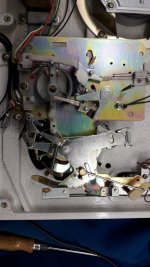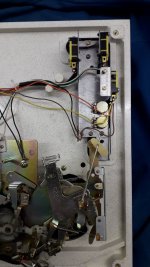Hello together,
I`ve had the opportunity to a get my hands on an may be 40 years old KD 5070.
It runs. Plate is spinning
Automatic mode dosn`t work at first time, some parts inside was stiff because they didnt move the last 10-20 Years.
Moving manually helped i little bit, now all is working.
Next i will test the output, to ensure the cartridge is working.
Have someone the same turntable and made a fresh up?
Which points are important? what is useful to do?
Would you change some parts if everything is working? Capacitors may be?
Do someone have the service manual drawings / Schematics / assembly instructions?
I have only found the owners manual, but this will not help me that much.
I`ve had the opportunity to a get my hands on an may be 40 years old KD 5070.
It runs. Plate is spinning
Automatic mode dosn`t work at first time, some parts inside was stiff because they didnt move the last 10-20 Years.
Moving manually helped i little bit, now all is working.
Next i will test the output, to ensure the cartridge is working.
Have someone the same turntable and made a fresh up?
Which points are important? what is useful to do?
Would you change some parts if everything is working? Capacitors may be?
Do someone have the service manual drawings / Schematics / assembly instructions?
I have only found the owners manual, but this will not help me that much.
Attachments
Hi Mate, check out Vinyl Engine https://www.vinylengine.com/
for all your TTable manuals. I have a couple Kenwood TTs, can't remember right now the models.
Cheers,
TAE
for all your TTable manuals. I have a couple Kenwood TTs, can't remember right now the models.
Cheers,
TAE
Good Idea but no registration possible at this time.
So i dont get the SM 🙁
If someone have a copy on his PC, can you please PM me.

So i dont get the SM 🙁
If someone have a copy on his PC, can you please PM me.
I have 2 KD series decks, one is a 990 and another with different number but effectively the same. Both stopped playing but on the 990 I replaced all the electrolytics, it still doesn't work.I now have to do a continuity check. It's useful having 2 because I can always cannibalise one for the other. I really don't want to buy another deck because these are so damn good and they come with excellent gimbal arms that are so easy to set up. To buy an equivalent deck today would mean shelling out serious money and I want to digitize about 500 LPs and then get rid of my entire analogue chain.Hi Mate, check out Vinyl Engine https://www.vinylengine.com/
for all your TTable manuals. I have a couple Kenwood TTs, can't remember right now the models.
Cheers,
TAE
I now see that d/d decks are once again being made, once you've tried as good Japanese d/d they make a nonsense of other forms.
Ralf - thanks for the input but that's a different model, different arm, different layout. I have the service manual for the 990 but sadly no parts are available today. If it's one of the i/cs that has gone then I can hopefully use one of the same from the other deck. Both decks came from Germany and the first i bought was from an audio shop. Surprisingly it was badly packed not something you expect from a German. It had been dropped in transit and a coner of the plinth was damaged but so well is the deck made that it still played perfectly for another 10 years. The continuity check should identify the problem which is a gradual shut down of all systems. It could be the Tx or somewhere in the power supply to the rest of the PCB.
Thanks for the manual that will help a lot, for start.
But i`ve expected some Infos about the direct drive motor and how to lubricate the platter bearing.
The instruction manual says -permanent lubricated bearings operate for more than 20000h.
My TT is far away from 20000h but >40 years old.
Do i have to pay some attention to the platter bearing? Or is it better to keep my hands off it?
But i`ve expected some Infos about the direct drive motor and how to lubricate the platter bearing.
The instruction manual says -permanent lubricated bearings operate for more than 20000h.
My TT is far away from 20000h but >40 years old.
Do i have to pay some attention to the platter bearing? Or is it better to keep my hands off it?
Danger Mouse,
looking at the photos I think the platter bearing is completely different to the 990. In the 990 it's a rod made of steel alloy that sit's on the polished head of a huge nut. The whole rod is the bearing and it is rifled so that the oil - Slick 50 is permanently lubricating the cylindrical face and base of the rod. The tolerances are so tight that if they were any tighter it couldn't operate. For this reason it is very difficult to remove the rod which is attached to the platter. This results in virtually silent operation, the S/N figure is impressive. It is only nec. to remove, clean and reapply the Slick 50 every 2 years. The normal ball and cup bearing in a lot of decks is really primitive in comparison.
looking at the photos I think the platter bearing is completely different to the 990. In the 990 it's a rod made of steel alloy that sit's on the polished head of a huge nut. The whole rod is the bearing and it is rifled so that the oil - Slick 50 is permanently lubricating the cylindrical face and base of the rod. The tolerances are so tight that if they were any tighter it couldn't operate. For this reason it is very difficult to remove the rod which is attached to the platter. This results in virtually silent operation, the S/N figure is impressive. It is only nec. to remove, clean and reapply the Slick 50 every 2 years. The normal ball and cup bearing in a lot of decks is really primitive in comparison.
- Home
- Source & Line
- Analogue Source
- Restoration / fresh up Kenwood KD-5070


